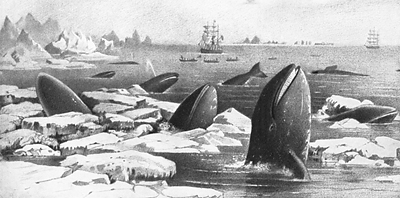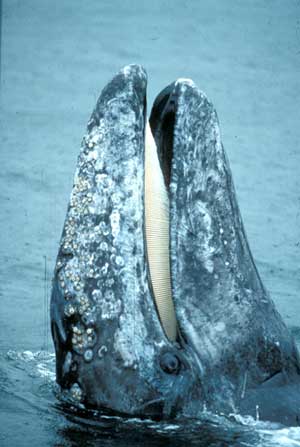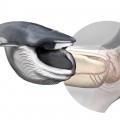Gray whales survived many cycles of global cooling and warming over the past few million years, likely by exploiting a more varied diet than they do today, according to a new study by University of California, Berkeley, and Smithsonian Institution paleontologists.

Unlike other baleen whales, gray whales feed on bottom-dwelling organisms by suctioning sediments and filtering out worms and crustaceans. (Courtesy of Flip Nicklin)
The researchers, who analyzed California gray whale (Eschrichtius robustus) responses to climate change over the past 120,000 years, also found evidence to support the idea that the population of gray whales along the Pacific Coast before the arrival of humans was two to four times today’s population, which stands at about 22,000. The whale is considered a conservation success story because protections instituted as early as the 1930s have allowed populations to rebound from fewer than 1,000 individuals in the early 20th century, after less than 75 years of systematic whaling.
“There almost certainly were higher gray whale populations in the past,” said evolutionary biologist David Lindberg, a UC Berkeley professor of integrative biology who coauthored the paper with his former student, Nicholas D. Pyenson, now curator of fossil marine mammals at the Smithsonian’s National Museum of Natural History in Washington, D.C. The paper appeared in the online, open-access journal PLoS ONE.
Lindberg and Pyenson suggest that higher populations in the past were possible because gray whales utilized a greater variety of food resources – resources that today’s whales are only now beginning to exploit. According to Lindberg, gray whales were once thought to feed only by suctioning seafloor sediment and filtering out worms and amphipods – so-called benthic organisms. But some whales are now eating herring and krill as well, just like their baleen whale relatives, which include the humpback and the blue.

This 19th century drawing depicts gray whales cavorting among ice floes in the norhtern Pacific Ocean. This observation suggests that gray whales can tolerate pack ice, a trait that helped it survive ice ages. (From Scammon, 1874)
Some whales are even dropping out of the migratory rat race. One group hangs out year-round off Vancouver Island in Canada, where they chase herring and krill.
“We propose that gray whales survived the disappearance of their primary feeding ground by employing generalist filter-feeding modes, similar to the resident gray whales found between northern Washington State and Vancouver Island,” the scientists write in their paper.
“A combination of low population numbers and a species migrating between places where humans didn’t bother them gave us the impression that gray whales have a stereotypical migratory and feeding behavior that may not be historically correct,” Lindberg said.
The new population numbers accord with a 2007 estimate that the California gray whale population was likely 76,000 to 120,000 before humans began hunting them. That estimate, by Stephen Palumbi of Stanford University and his collaborators, was based on an analysis of gray whale genetic diversity.
The numbers clash, however, with claims by some ecologists that populations of between 15,000 and 20,000 are likely the most that the Pacific Coast – specifically along the whales’ 11,000 kilometer (6,900 mile) migratory route from Baja California to the Bering Sea – could support, today or in the past.
“Our data say that, if the higher estimates are right, gray whales would have made it through the Ice Ages in numbers sufficiently large to avoid bottlenecking,” Pyenson said. “If gray whale populations were at the lower levels, they would only have squeaked through the ice ages with populations of hundreds or a few thousand. That would have left bottlenecking evidence in their DNA.”
Bottlenecking is when populations drop so low that inbreeding becomes common, decreasing the genetic diversity in the species and making them less able to adapt to environmental change.
Gray whales are survivors
The new assessment is good news for gray whales, which appear to have “a lot more evolutionary plasticity than anyone imagined,” Lindberg said. This could help them survive the climate change predicted within the next few centuries that is characterized by an expected sea level rise of several meters.
“I suspect the gray whales will be among the winners in the great climate change experiment,” Pyenson said.
Lindberg and Pyenson initiated the study several years ago in the face of conflicting and contentious estimates for past gray whale populations. They thought that an understanding of how gray whales adapted to climate change over the past 3 million years, the period called the Pleistocene, might provide insight into how they will adapt to climate change today.
Since gray whales arose – the oldest fossils date from 2.5 million years ago – Earth has gone through more than 40 major cycles of warming and cooling, each of which significantly affected the world’s flora and fauna. During the last glacial cold spell, between 50,000 and 10,000 years ago, most of the large terrestrial mammals disappeared through a combination of climate change and human depredation, Lindberg noted. The marine realm, however, experienced almost no extinctions and very few new originations during that same period.
–-Source: Robert Sanders, University of California, Berkeley








